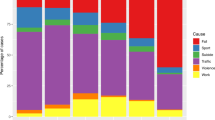Abstract
Study design
Retrospective cohort study.
Objectives
To determine the incidence and characteristics of newly injured individuals admitted to a traumatic spinal cord injury (TSCI) referral center during a 4-year period.
Setting
University Hospital of Valle, Cali, Colombia.
Methods
Individuals were identified, and their data was recorded based on the International Spinal Cord Injury Core Data Set. The outcome of interest was the American Spinal Injury Association Impairment Scale (AIS) grade at the last follow-up.
Results
There were 491 individuals admitted in the 4-year period. The mean annual incidence of TSCI was 56.27 per million inhabitants. Considering TSCI in individuals exclusively from Cali, the mean annual incidence was 27.78 per million. The leading cause of TSCI was interpersonal violence (47.25%) and falls (33.60%). There was a strong correlation between AIS grade at admission and last follow-up. The most common AIS grade at the last follow-up was E (34.01%) caused mostly by falls (57.48%), followed by A (31.16%) caused mostly by interpersonal violence (76.27%). The reported employment rate dropped from 75.56% to 18.94% before and after TSCI (p < 0.05). AIS grade A was associated with more post-injury complications (p < 0.05).
Conclusions
This is the first cohort study in Colombia describing the incidence and AIS grades of individuals with TSCI from a trauma referral center. Interpersonal violence was overrepresented in this population. Future research should include the evaluation of prevention strategies, as well as research on interventions towards quality improvement in patient care and post-discharge services especially for individuals with AIS grade A.
Similar content being viewed by others
Log in or create a free account to read this content
Gain free access to this article, as well as selected content from this journal and more on nature.com
or
Data availability
The datasets generated and/or analyzed during the current study are available from the corresponding author on reasonable request.
References
International perspectives on spinal cord injury. World Health Organization International Spinal Cord Society; 2013. Report No.: 9241564660.
Lee BB, Cripps RA, Fitzharris M, Wing PC. The global map for traumatic spinal cord injury epidemiology: update 2011, global incidence rate. Spinal Cord. 2014;52:110–6.
Kumar R, Lim J, Mekary RA, Rattani A, Dewan MC, Sharif SY, et al. Traumatic spinal injury: global epidemiology and worldwide volume. World Neurosurg. 2018;113:e345–e63.
Cao Y, Krause JS. Estimation of indirect costs based on employment and earnings changes after spinal cord injury: an observational study. Spinal Cord. 2020;58:908–13.
Muggah R, Tobón KA. Reducing Latin America’s violent hot spots. Aggress Violent Behav. 2019;47:253–6.
Martínez L, Prada S, Estrada D. Homicides, public goods, and population health in the context of high urban violence rates in Cali, Colombia. J Urban Health. 2018;95:391–400.
National Institute of Legal Medicine and Forensic Sciences V. [Forensis 2018. Data for life] Bogota, D.C.: National Institute of Legal Medicine and Forensic Sciences; 2019 [cited 27 Dec 2020]. https://www.medicinalegal.gov.co/documents/20143/386932/Forensis+2018.pdf/be4816a4-3da3-1ff0-2779-e7b5e3962d60.
Instituto Nacional de Salud. Protocolo de Vigilancia en Salud Pública. Lesiones de Causas Externas. Bogotá: Instituto Nacional de Salud; 2016.
Castaño A. Lesiones no fatales en accidentes de tránsito-Colombia, 2005. Instituto nacional de medicina legal y ciencias Forenses-DRIP; 2006.
Ordoñez CA, Morales M, Rojas-Mirquez JC, Bonilla-Escobar FJ, Badiel M, Miñán Arana F, et al. Trauma Registry of the Pan-American Trauma Society: one year of experience in two hospitals in southwest Colombia. Colomb Med. 2016;47:148–54.
Teheran AACO, Frade LL. Incidence and characteristics of spinal trauma in a level III hospital, Bogotá 2011–2014]. Panam J Trauma Crit Care Emerg Surg. 2016;5:140–7.
Carvajal CPC, Gomez-Rojo C, Calderon J, Cadavid C, Jaimes F. Clinical and demographic characteristics of patients with spinal cord injury. Six years experience. Acta Med Colomb. 2014;40:45–50.
DeVivo M, Charliefue S, V Noonan V, Post M, Stripling T, Wing P. International spinal cord injury core data set. Nature; 2006. p. 535-40.
Kirshblum SC, Burns SP, Biering-Sorensen F, Donovan W, Graves DE, Jha A, et al. International standards for neurological classification of spinal cord injury (revised 2011). J Spinal Cord Med. 2011;34:535–46.
(DANE). ADoNS. Population projections. Bogota D.C., DANE 2020 [updated Dec 16, 2020; cited 27 Dec 2020]. https://www.dane.gov.co/index.php/estadisticas-por-tema/demografia-y-poblacion/proyecciones-de-poblacion.
Mitchell J, Nunnerley J, Frampton C, Croot T, Patel A, Schouten R. Epidemiology of traumatic spinal cord injury in New Zealand (2007–2016). NZ Med J. 2020;133:47.
Johansson E, Luoto TM, Vainionpää A, Kauppila A-M, Kallinen M, Väärälä E, et al. Epidemiology of traumatic spinal cord injury in Finland. Spinal Cord. 2020:1-8. https://www.nature.com/search?q=Epidemiology+of+traumatic+spinal+cord+injury+in+Finland&journal=sc; https://pubmed.ncbi.nlm.nih.gov/33149235/.
Halvorsen A, Pettersen AL, Nilsen SM, Halle KK, Schaanning EE, Rekand T. Epidemiology of traumatic spinal cord injury in Norway in 2012–2016: a registry-based cross-sectional study. Spinal Cord. 2019;57:331–8.
Ning G-Z, Wu Q, Li Y-L, Feng S-Q. Epidemiology of traumatic spinal cord injury in Asia: a systematic review. J Spinal Cord Med. 2012;35:229–39.
Campos I, Margalho P, Lopes A, Branco C, Faria F, Caldas J, et al. People with spinal cord injury in Portugal. Am J Phys Med Rehabil. 2017;96(Suppl 1):S106–S8.
Deconinck H. The health condition of spinal cord injuries in two Afghan towns. Spinal Cord. 2003;41:303–9.
Zárate-Kalfópulos B, Jiménez-González A, Reyes-Sánchez A, Robles-Ortiz R, Cabrera-Aldana EE, Rosales-Olivarez LM. Demographic and clinical characteristics of patients with spinal cord injury: a single hospital-based study. Spinal Cord. 2016;54:1016–9.
Cross CP, Copping LT, Campbell A. Sex differences in impulsivity: a meta-analysis. Psychol Bull. 2011;137:97–130.
Bonilla-Escobar FJ, Herrera-López ML, Ortega-Lenis D, Medina-Murillo JJ, Fandiño-Losada A, Jaramillo-Molina C, et al. Driving under the influence of alcohol in Cali, Colombia: prevalence and consumption patterns, 2013. Int J Inj Contr Saf Promot. 2016;23:179–88.
Bellucci CH, Castro Filho JE, Gomes CM, Bessa Junior J, Battistella LR, Souza DR, et al. Contemporary trends in the epidemiology of traumatic spinal cord injury: changes in age and etiology. Neuroepidemiology. 2015;44:85–90.
Martínez-Ruíz DM, Fandiño-Losada A, Ponce de Leon A, Arango-Londoño D, Mateus JC, Jaramillo-Molina C, et al. Impact evaluation of camera enforcement for traffic violations in Cali, Colombia, 2008–2014. Accid Anal Prev. 2019;125:267–74.
Osorio-Cuéllar GV, Pacichana-Quinayaz SG, Bonilla-Escobar FJ, Fandiño-Losada A, Jaramillo-Molina C, Gutiérrez-Martínez MI. First motorcycle-exclusive lane (Motovia) in Colombia: perceptions of users in Cali, 2012–2013. Int J Inj Control Saf Promot. 2017;24:145–51.
Gun violence in Colombia. Bull World Health Organ. 2019;97:733–4.
Togan T, Azap OK, Durukan E, Arslan H. The prevalence, etiologic agents and risk factors for urinary tract infection among spinal cord injury patients. Jundishapur J Microbiol. 2014;7:e8905–e.
Acknowledgements
The authors thank Adnan Mujanović for his critical revisions to the manuscript.
Author information
Authors and Affiliations
Corresponding author
Ethics declarations
Conflict of interest
The authors declare no competing interests.
Ethics
The study was approved by the University Hospital of Valle Ethics Committee and the Human Ethics Committee of the Universidad del Valle with code 143-018. The authors certify that all applicable institutional and governmental regulations concerning the ethical use of human’s information were followed during the course of this research and the Institutional Review Board waived the requirement for informed consent to access patient health information as the study does not involved more than minimal risk to the privacy of individuals.
Additional information
Publisher’s note Springer Nature remains neutral with regard to jurisdictional claims in published maps and institutional affiliations.
Rights and permissions
About this article
Cite this article
Giraldo, Y.A., Castro, J.L., Tovar-Sánchez, M.A. et al. Epidemiology of traumatic spinal cord injuries in Colombia. Spinal Cord Ser Cases 7, 42 (2021). https://doi.org/10.1038/s41394-021-00408-3
Received:
Revised:
Accepted:
Published:
DOI: https://doi.org/10.1038/s41394-021-00408-3
This article is cited by
-
Factors associated with neuropathic pain in Colombian patients with spinal cord injury of traumatic origin: case–control study
Spinal Cord Series and Cases (2022)



